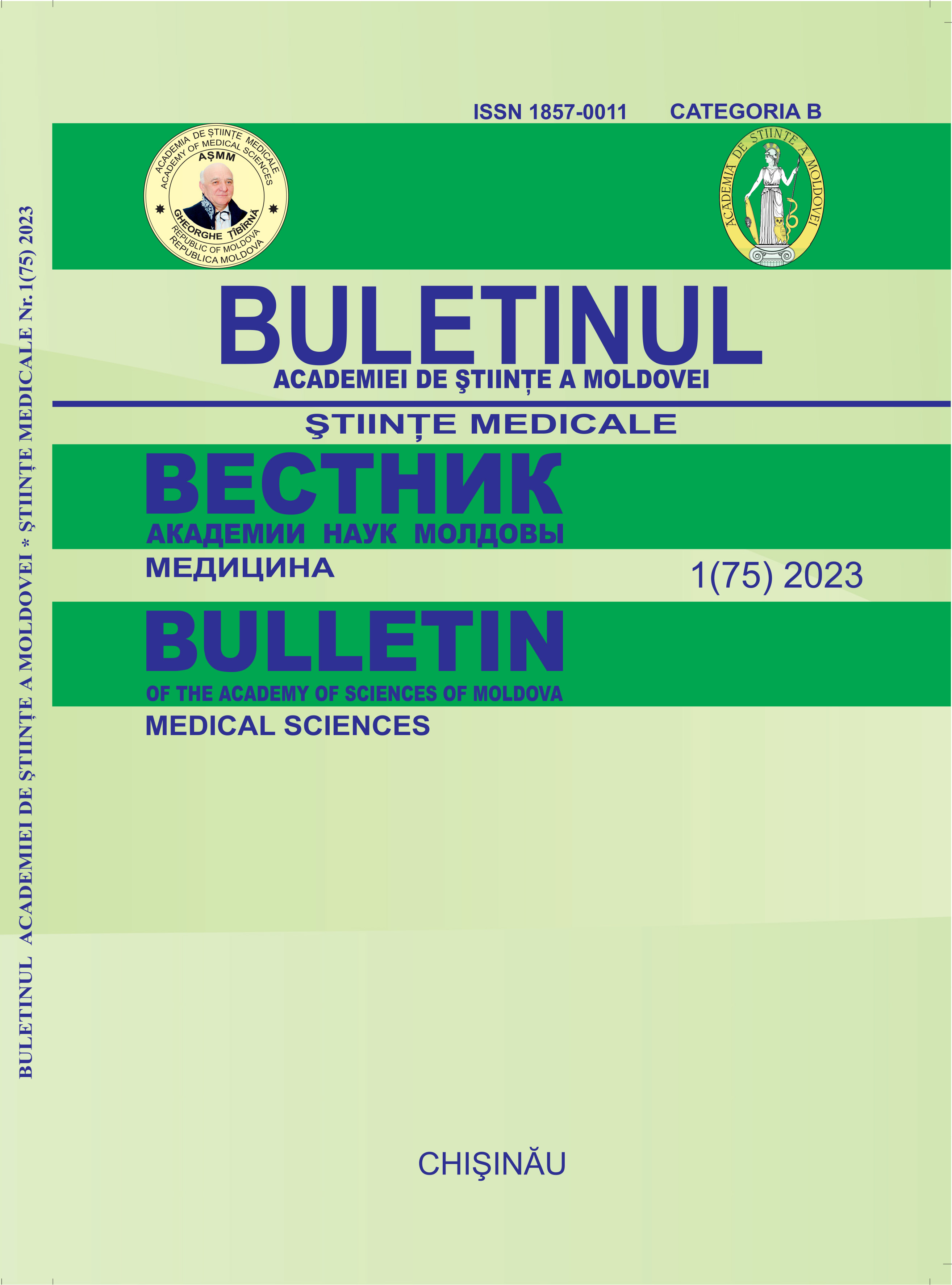Multi-marker panel in patients with NSTEMI: pillars of pathogenesis and diagnostics
DOI:
https://doi.org/10.52692/1857-0011.2023.1-75.05Keywords:
NSTEMI, multi-marker panel, pathogenesis, diagnosticsAbstract
Aim. Assessment within the multi-marker panel applied to patients with NSTEMI of admission levels of the main markers of cardiovascular pathology in order to disentangle the pathogenetic interface and identify diagnostic predictors. Material and methods. The research was carried out on a group of 87 patients with NSTEMI, exposed to angioplas-ty, in which the admission values of 2 morphofunctional markers of endothelial dysfunction were determined, as well as the serum levels of 53 biochemical markers with reference to: inflammation, oxidative stress, endothelial dysfunction, cell injury, hemostasis disorder, myocardial and extracellular matrix (ECM) remodeling. The control group has consisted of 40 apparently healthy people.Results. The analysis of the multi-makrer panel revealed significant deviations of the majority of the explored markers compared to the control level. Endothelial dysfunction was marked by the increase of thickness of the medial-intima complex of the carotid artery and the decrease of the flow-mediated dilation of brachial artery in association with a 7694% raise of endothelial cell fragments (EF), phospholipase A2 (PhA2) and angiopoietin 2 (Ang 2). Among 16 markers of inflammation, the elevation of myeloperoxidase (MPO) by 156% is remarkable as a specific marker of NETosis. Activated oxidative stress is the result of the impairment of the antioxidant defense, and hemostasis disorder must be underlined by double increase of fibrin monomers (FM). From a pathogenetic point of view, the multiple increase (more than 8 times) of cardiac myosin-binding protein (cMyBP-C) is important and understandable, and the markers of myocardial and ECM remodeling basically demonstrated an activation of several types of metalloproteinases. Conclusion. From the spectrum of the multi-marker panel applied to patients with NSTEMI, markers with plausible diagnostic value due to inteligibly reflected pathogenetic mechanism are highlighted as: MPO, PhA2, Ang 2, EF, FM, and cMyBP-C.
References
Alzuhairi KS, Sogaard P, Ravkilde J. et al. Longterm prognosis of patients with non-ST-segment elevation myocardial infarction according to coronary arteries atherosclerosis extent on coronary angiography: a historical cohort study. BMC Cardiovasc Disord, 2017, 17(279). https://doi.org/10.1186/s12872-017-0710-3.
Chang SS, Lu CR, Lu Cr et al. Prognosis between ST-elevation and ST-elevation myocardial infarction in older adult patients. Front Cardiovsc Med, 2022, 8:749072, Doi: 10.3389/fcvm.2021.749072.
Ayad SW, El Zawawy TH, Lotfy MI et al. Incidence and impact of totally occluded culprit coronary artery in patients with non-ST segment elevation myocardial infarction acute coronary syndrome. Egypt Heart J, 2021, 73(36). https://doi.org/10.1186/s43044-021-00160-x.
Collet JP, Thiele H, Barbato E et al. 2020 ESC Guidelines for the management of acute coronary syndromes in patients presenting without persistent ST-segment elevation: The Task Force for the management of acute coronary syndromes in patients presenting without persistent ST-segment elevation of the European Society of Cardiology (ESC). European Heart Journal, 2021, 42(14): 1289–1367. Doi: https://doi.org/10.1093/eurheartj/ehaa575.
Zhen C, Hailin Z, Lingzhi W et al. The Role of Neutrophil NETosis in Organ Injury: Novel Inflammatory Cell Death Mechanisms. Inflammation, 2020, 43(6):2021-2032.
Shah M, Yellon DM, Davidson SM. The Role of Extracellular DNA and Histones in Ischaemia-Reperfusion Injury of the Myocardium. Cardiovasc Drugs Ther, 2020, 34:123– 131. Doi: https://doi.org/10.1007/s10557-020-06946-6.
Tardif JC, Tanguay JF, Wright SS et al. Effects of the P-selectin antagonist inclacumab on myocardial damage after percutaneous coronary intervention for non-stsegment elevation myocardial infarction: results of the SELECT-ACS trial. J Am Coll Cardiol. 2013,61:2048–55.
Rizo-Tellez SA, Sekheri M, Filep JG. Myeloperoxidase: Regulation of Neutrophil Function and Target for Therapy. Antioxidants, 2022, 11:2302. Doi: https://doi.org/10.3390/antiox11112302.
Ali M, Pulli B, Courties G. Myeloperoxidase Inhibition Improves Ventricular Function and Remodeling After Experimental Myocardial Infarction. JACC Basic Transl Sci, 2016, 1(7):633-643.
Zhang, H., Gao, Y., Wu, D. et al. The relationship of lipoprotein-associated phospholipase A2 activity with the seriousness of coronary artery disease. BMC Cardiovasc Disord, 2020, 20:295. https://doi.org/10.1186/s12872-020-01580-4.
Skowerski T, Nabradalik K, Lwiendacz H et al. Angiopoietin-2 as a biomarker of non-ST-segment elevation myocardial infarction in patients with or without type 2 diabetes. Arch Med Sci, 2022, 18(3): 624–631. Doi: https:// doi.org/10.5114/aoms.2019.89201.
Abbas M, Jesel L, Auger C et al. Endothelial Microparticles From Acute Coronary Syndrome Patients Induce Premature Coronary Artery Endothelial Cell Aging and Thrombogenicity. Circulation, 2017, 135:280-296. Doi: https://doi.org/10.1161/CIRCULATIONAHA.116.017513.
Yoshihisa A, Sato Y, Kimishima Y et al. Soluble fibrin monomer complex is associated with cardioand cerebrovascular events in patients with heart failure. IJC Heart and Vasculature, 2021, 32: 100697. Doi: https://doi.org/10.1016/j.ijcha.2020.100697.
Abdula MN, Hashim RD. Role of cmybp-c in the diagnosis of acute coronary syndrome. Biochemical and Cellular Archives, 2020, 20(1):1271-1273. Doi: 10.35124/ bca.2020.20.1.1271.
Sadayappan S. Cardiac myosin binding protein-C: a potential early-stage, cardiac-specific biomarker of ischemia-reperfusion injury. Biomark Med, 2012, 6(1):6972. Doi: 10.2217/bmm.11.100.
Panotopoulos C, Magiorkins E, Spyrantis A, Kotsiri I. Cardiac Myosin-Binding Protein C as a New Biomarker in the Diagnosis of Myocardial Infarction. J of Advances in Medicine and Medical Research, 2022, 34(23):446-453. DOI:10.9734/jammr/2022/v34i234881.
Downloads
Published
License
Copyright (c) 2023 Bulletin of the Academy of Sciences of Moldova. Medical Sciences

This work is licensed under a Creative Commons Attribution 4.0 International License.



